The portable benchtop spectrophotometer TS8290 is a spectrophotometer
developed by 3nh using its own core technology of spectroscopy. It uses
a built-in silicon photodiode array (40 pairs of dual-row) sensors and
an imported whiteboard. It also takes into account the measurement speed
and the convenience of operation. Rotating and pressing structure makes
testing more convenient. The repeatability ΔE*ab of TS8290 portable benchtop
spectrophotometer is easily controlled within 0.05, and the inter-instrument
error ΔE*ab is controlled within 0.15. The measurement is accurate and
can be used for accurate color analysis and transmission in the laboratory.
TS8290 Portable Benchtop Spectrophotometer Application
The TS8290 portable benchtop spectrophotometer is equipped with a Φ30mm
measuring aperture, which is suitable for measuring large-area samples,
meeting the requirements of accurate color measurement and quality control
in textile and garment printing and dyeing, plastic electronics, ceramics
and other industries; it can be used for fluorescent sample measurement.
Features of TS8290 Portable Benchtop Spectrophotometer
1. It adopts the internationally-used D/8 structure, compatible with SCI/SCE measurement, and supports SCI+SCE rapid measurement at the same time
The TS8290 benchtop spectrophotometer adopts the internationally applicable D/8 illumination observation conditions, SCI/SCE (including specular reflection/not including specular reflection) synthesis technology, and supports SCI+SCE simultaneous rapid measurement, the test time is about 3.2 seconds.
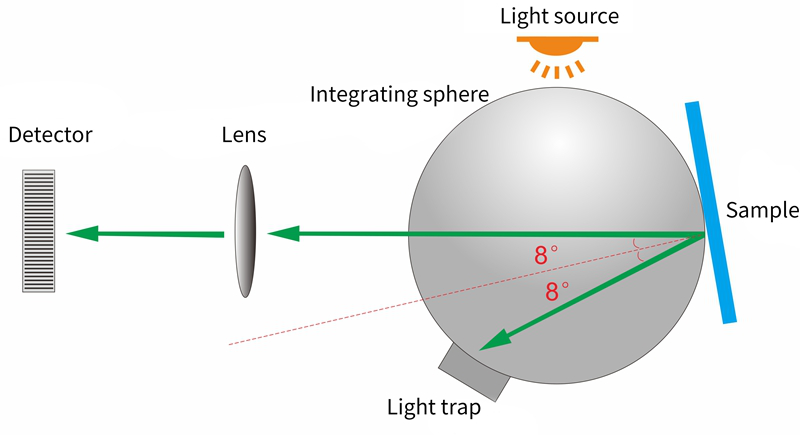
2. Silicon photodiode array (dual 40 array) sensor
Larger area dual 40 array sensor, strong light will not saturate, low
light sensitivity higher and wider spectral response range, ensuring the
measurement speed, accuracy, stability and consistency of the instrument.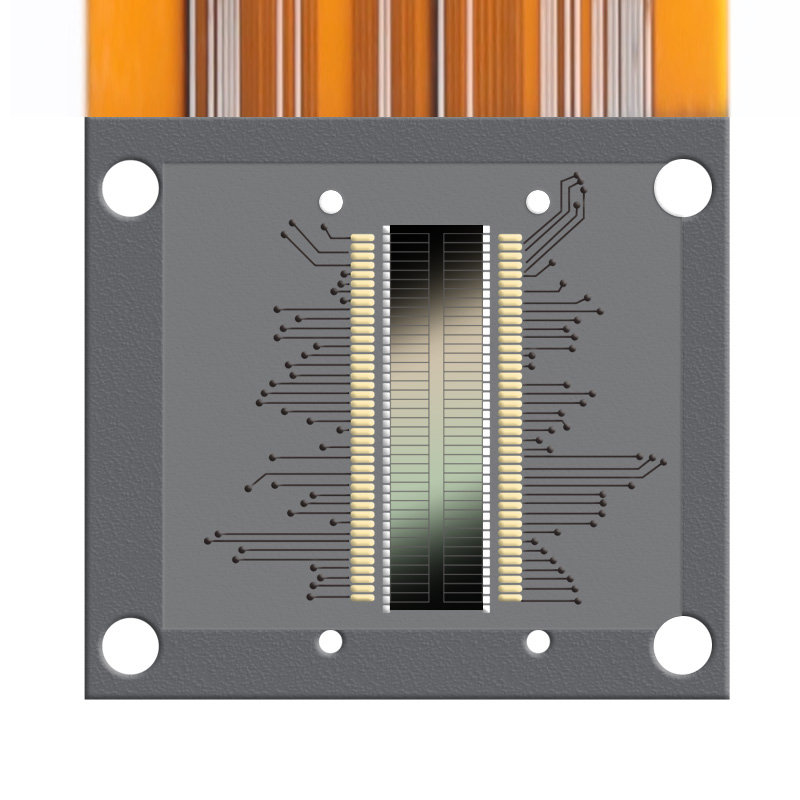
3. Multiple color measurement spaces, multiple observation light sources
TS8290 benchtop spectrophotometer provides CIE LAB, XYZ, Yxy, LCh, CIE
LUV, Musell, s-RGB, HunterLab, βxy, DIN Lab99 color space, as well as D65,A,C,D50,D55,D75,F1,F2(CWF),F3,F4,F5,F6,F7(DLF),F8,F9,F10(TPL5),F11(TL84),F12(TL83/U30)
multiple observation light sources, which can meet the special measurement
requirements under different measurement conditions.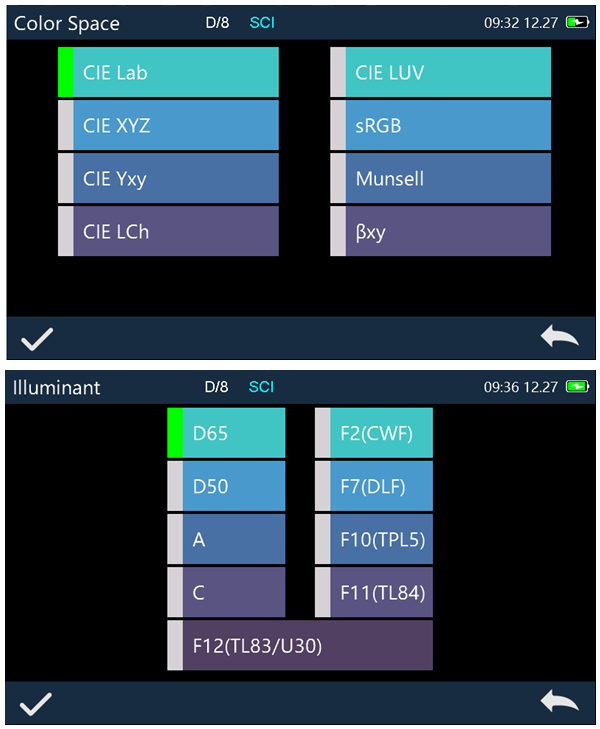 4. Adopt a combined full-spectrum LED light source and UV light source
4. Adopt a combined full-spectrum LED light source and UV light source
The full-band balanced LED light source ensures sufficient spectral distribution in the visible light range, avoids the lack of spectrum of white light LEDs in specific wavelength bands, and ensures the measurement speed of the instrument and the accuracy of the measurement results. Professional UV light sources ensure UV testing more reliable.
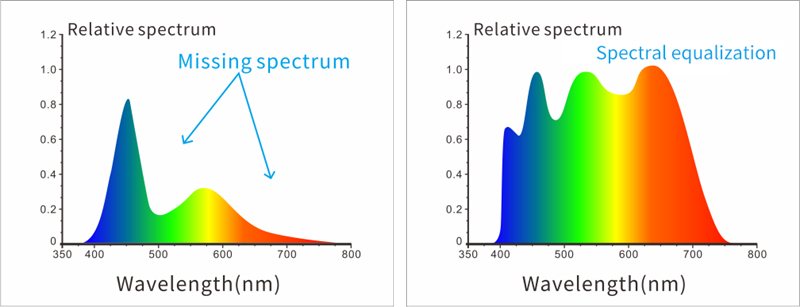
5. Metrological verification report
Each TS8290 benchtop spectrophotometer has been verified and tested, and the instrument is verified according to the measurement standards of the authoritative verification department at the factory, and the measurement data is traced to the National Institute of Metrology to ensure the authority of the instrument test data.
6. Camera locating, can clearly observe the measured area
The TS8290 portable benchtop spectrophotometer has a built-in camera for framing and positioning. Through the real-time framing of the camera, it can accurately determine whether the measured part of the object is the center of the target, which improves the measurement efficiency and accuracy.
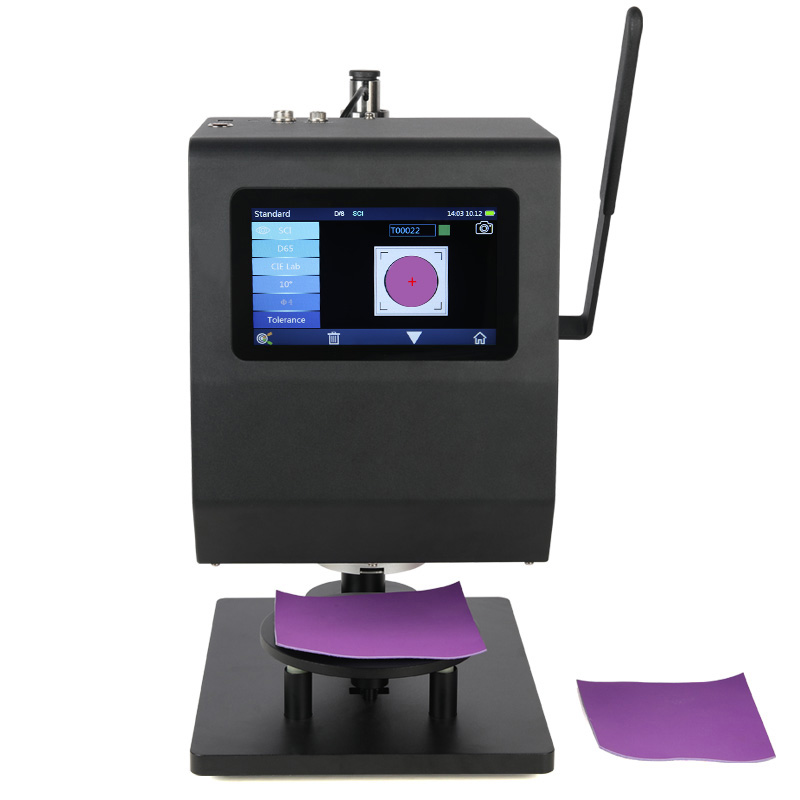
7. Industrial-grade high-definition touch screen, easy-to-use user interface
Using a 7-inch industrial-grade high-definition touch screen, the control is smooth, and the easy-to-use user interface makes the operation comfortable, convenient and easier to use.

8. Color management software
The SQCX quality management software matched with the TS8290 benchtop spectrophotometer is suitable for quality monitoring and color data management in various industries. Data the user's color management, compare color differences, generate test reports, provide a variety of color space measurement data, and customize customer color management.
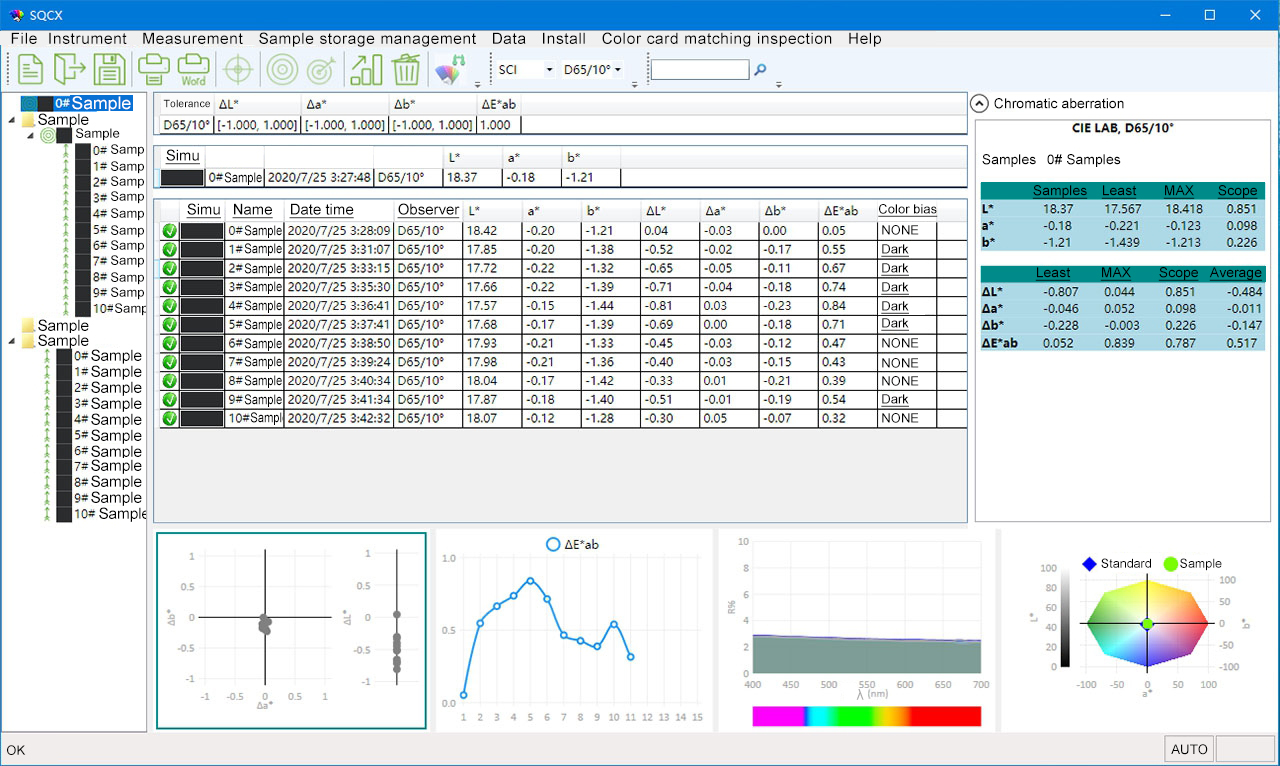
Technical Parameters Of TS8290 Portable Benchtop Spectrophotometer
| Model | TS8290 |
| Optical Geometry |
D/8 (diffuse illumination, 8° direction reception); SCI/SCE measurement; include UV/exclude UV measurement; Comply with standard CIE No.15, GB/T 3978, GB 2893, GB/T 18833, ISO7724-1, ASTM E1164, DIN5033 Teil7 |
| Features |
Φ30mm measuring aperture, suitable for measuring large area samples; Standard configuration of rotary pressing structure, more convenient for testing; Accurate measurement, can be used for accurate analysis and transmission of laboratory colors; It is used for accurate color measurement and quality control in textile and garment printing and dyeing, plastic electronics, ceramics and other industries; it can be used for fluorescent sample measurement. |
| Integrating Sphere Size | Φ152mm |
| Light Source | Combined full spectrum LED light source, UV light source |
| Spectrophotometric Mode | Plane Grating |
| Sensor | Silicon photodiode array (40 groups in dual rows) |
| Wavelength Range | 400~700nm |
| Wavelength Interval | 10nm |
| Semiband Width | 10nm |
| Measured Reflectance Range | 0-200% |
| Measuring Aperture | Φ30mm/Φ25.4mm |
| Specular Component | Simultaneously test SCI/SCE |
| Color Space | CIE LAB,XYZ,Yxy,LCh,CIE LUV,s-RGB,HunterLab,βxy,DIN Lab99 Munsell(C/2) |
| Color Difference Formula | ΔE*ab,ΔE*uv,ΔE*94,ΔE*cmc(2:1),ΔE*cmc(1:1),ΔE*00, DINΔE99,ΔE(Hunter) |
| Other Colorimetric Index |
WI (ASTM E313, CIE/ISO, AATCC, Hunter), YI (ASTM D1925, ASTM 313), Metamerism index Mt, Staining Fastness, Color Fastness, Color Strength, Opacity, 8° gloss, 555 color classification |
| Observer Angle | 2°/10° |
| Illuminant | D65,A,C,D50,D55,D75,F1,F2(CWF),F3,F4,F5,F6,F7(DLF),F8,F9,F10(TPL5),F11(TL84),F12(TL83/U30) |
| Displayed Data | Spectrogram/Values, Samples Chromaticity Values, Color Difference Values/Graph, PASS/FAIL Result, Color Simulation, Color Offset |
| Measuring Time | About 1.5s (Measure SCI & SCE about 3.2s) |
| Repeatability | Chromaticity value:MAV/SCI, within ΔE*ab 0.05 (After the instrument is warmed up and calibrated, measure the average value of the whiteboard 30 times at an interval of 5s) |
| Inter-instrument Error | MAV/SCI, Within ΔE*ab 0.15(Measured average value of 12 tiles of BCRA series Ⅱ) |
| Measurement method | Single measurement, average measurement (2~99 times) |
| Locating | Camera lpcating |
| Dimension | L*W*H=425X250X470mm |
| Weight | Approx. 18kg |
| Power | AC 24V, 3A Power adapter power supply |
| Illuminant Life Span | 5 years, more than 3 million times measurements |
| Display | 7-inch TFT color LCD, Capacitive Touch Screen |
| Data Port | USB, Bluetooth®5.0, Trigger switch interface |
| Data Storage | Standard 1000 Pcs, Sample 30000 Pcs(SCI/SCE counts as one piece of data) |
| Language | Simplified Chinese, Traditional Chinese, English |
| Operating Environment | 0~40℃, 0~85%RH (no condensation), altitude: less than 2000m |
| Storage Environment | -20~50℃, 0~85%RH (no condensation) |
| Standard Accessory | Power adapter, data cable, manual, quality management software (download from official website), calibration box, measuring aperture, rotating bracket |
| Optional Accessory | Mini printer, Foot switch |
| Notes | The specifications are subject to change without notice. |
1. When I received NH310/NH300 colorimeter and perform measurement, why the measured data is abnormal?
After receiving NH310/NH300, you have to perform white and black calibration manually when first starting.
2. In which condition, manual white and black calibration and auto calibration are required for NH310?
a. It’s needed to perform manual calibration for NH310 when first starting.
b. In the subsequent starting, NH310 will perform auto calibration at startup. No need to perform manual calibration.
c. Suggestion: it’s best to perform manual calibration once a week or when NH310 measured data is not accurate.
3. In which condition, manual white and black calibration for NH300 is required?
a. It’s needed to perform manual calibration for NH300 when first starting.
b. In the subsequent starting, no need to perform manual calibration.
c. Suggestion: it’s best to perform manual calibration once a week or when NH300 measured data is not accurate.
4. How to replace NH310 measuring aperture?
There are three measuring apertures for NH310: Φ8mm (standard accessory), Φ4mm (standard accessory), extended Φ8mm (optional accessory)
a. Turning on
b. Removing measuring aperture, install the needed measuring aperture.
c. Select “Settings-Aperture Setting” in main menu to select corresponding measuring aperture.
d. After selecting aperture, the instrument will display “White and Black Calibration” interface. White and black calibration must be performed.
e. Replace completed.
5. CQCS3 (Color Quality Control System) Installation
a. Before installation, please Copy CQCS3 folder to your computer and don’t remove any files in CQCS3 folder.
b. Double-click the setup.exe to install CQCS3 software.
c. Then double-click Install.bat under the CQCS3\USB_Driver file to install the driver.
d. Detailed installation information please read the "Installing Software" under CQCS3 User manual.doc.
6. How to check communication port?
a. Connect colorimeter to the PC with USB cable.
b. Turn on the colorimeter to enter main menu. Select “Comm” and press “Enter” key to start communication.
c. Right click on “My Computer” on the desktop. Click “Manage” -> “Device Manager” -> “Ports”, you can see similar display as “SCI USB2Serial (COM6)”.
d. Click “Settings->Communication Parameters” in CQCS3 software interface. Select the corresponding port in “Serial Port”.
7. After completing CQCS3 installation, how to solve the problem if it display “! USB Device” or “! SCI USB2Serial (COM6)” when checking the communication port?
a. Right click “! USB Device” or “! SCI USB2Serial (COM6)”, “Update Driver” -> “Install from a list or specific location (Advanced)” -> “Next” ->“Include this location in the search” -> “Browse”, specify USB driver file path “CQCS3\USB_Driver”, click “Next”. Then it will install successfully.
b.Detailed installation information please refers to “2.2 Installing USB Driver” in Color Quality Management System User Manual.doc.
8. Notes for First Using CQCS3 Software
a. Users must specify Standard File Name, Sample File Name and Sample Database File Name when first use.
b.Standard File is use to store standard measurement data. Sample File is used to store sample measurement data. Sample Database File is used to store the measured data exported from sample records.
9. How to solve the problem when “Connection Timeout” occurred?
a. When the colorimeter is disconnected to the PC, “Connection Timeout” will occur. At the moment, you have to check whether the USB cable is well connected the colorimeter and the PC. Then you can re-plug the USB to try out.
b. After ensuring the colorimeter is connected to the PC with USB cable, turn on the colorimeter and enter the main menu. Select “Comm” and press “Enter” key to start communication.
c. Turn off CQCS3 software, and reopen it.
10. How to solve the problem when the interface display "USB Disconnect"
a. Check whether the USB cable is connected. If not, please connect it. Check whether the connection is effective. You can re-plug the USB cable to test.
b. If the USB cable is connected well but the interface still displays "USB Disconnect", please re-start the colorimeter and enter "Menu" -"Comm"to start the communication.
c. Change the USB cable or change the USB port in you PC.
11. How to solve the problem when the colorimeter cannot be turned on in the condition of battery-powered?
a. If this phenomenon occurred, it means the battery power is not enough. You need to charge the battery.
b. When charge the battery, please insert the battery to the instrument, and plug in the adapter to charge the battery. After 5 minutes, the instrument can be turned on.
c. If the instrument still cannot be turned on after charging 5 minutes, you can pull out the adapter and re-plug in to check it. Or repeat this operation.
d. If the instrument still cannot be turned on after charging 5 minutes, you can turn off the colorimeter and turn on it again to check it. Or repeat this operation.
e. If you have tried all the methods above but the colorimeter still cannot be turned on, please change the battery.